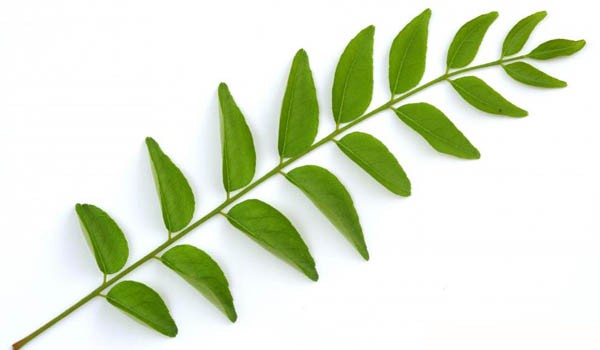- Overview
This item is Discontinued
Common name:Curry Leaf, Limro Botanical name: Murraya koenigii Family: Rutaceae Origin: India, Ceylon Avg Height X Width: 12' x 10' Damage temp: 28-30 F Curry Leaf/Limro Tree in a 3 gallon container. The curry leaf plant, is a native of Tropical Asia, southern India and Sri Lanka. Belonging to the Rutaceae family, the Murraya Koenigi plant grows to a height between 2 and five meters, depending on various factors. The leaves are small, pointed and in clusters, giving of a strong aroma faintly reminding one of citrus and anise. The aroma is delightful when added to curries and while frying spices, and lends that extra something to south Indian dishes. It also has many medicinal uses and is an anti-carcinegine as well as anti-oxidant. Can easily be kept in a container for easy access.
Description
Uses
Medicinal UsesCurry leaf (Murraya koenigii Spreng., Rutaceae), is a popular leafy-spice used in Asian-Indian cuisine for its characterizing authentic flavor and distinct aroma (Fig. 1). The curry leaf is used by Asian Americans originating from South Asia almost daily in its fresh form when available and is preserved as dried or frozen for long-term storage. Interest in greater use of curry leaf has been stimulated since its high antioxidant and anticarcinogenic potential were reported (Khan et al. 1997; Khanum et al. 2000), as well as the changing demographics nationwide that have created a ready market and greater demand for this spice (Palaniswamy 2001).
Family: Rutaceae
English name: Curry leaf-tree
Indian names: karepaku (Andhra Pradesh); narasingha, bishahari (Assam); barsanga, kartaphulli (Bengal); gorenimb, kadhilimbdo (Gujrat); mitha neem, gandhla, gandhela, gandhelu (Himachal Pradesh); kathnim, mitha neem, kurry patta gandhela, barsanga (Hindi); karibeva (Karnataka); kariveppilei (Kerala); gandhela, gandla, gani (Kumaon); bassan, basango, bhursanga (Orissa); surabhinimba, kalasaka, mahanimb (Sanskrit); karivempu, karuveppilei (Tamilnadu)
Murraya koenigii (L.) Spreng. is commonly found in the outer Himalayas, from the Ravi eastwards, ascending to 5,000 feet, in Assam, Chittagong, Upper and Lower Burma. It is also found in evergreen and deciduous forests of peninsular India, often as underwood (Brandis, 1906).
The shrub is of common occurrence in Himachal Pradesh in areas lying between 800 and 1,450 metres above the sea level. Almost every part of this plant has a strong characteristic odour. The people of the plains, particularly of southern India, use the leaves of this plant as a spice in different curry preparations.
Description
almost black, somewhat jelly-like pulp, soft, sr. In the center, there may be 1 to 10 flat, smooth, brown seeds, 3/4 to 1 in (2-2.5 cm) long, but the fruits are often seedless.
A small spreading shrub, about 2.5 metres high; the main stem, dark green to brownish, with numerous dots on it; its bark can be peeled off longitudinally, exposing the white wood underneath; the girth of the main stem is 16 cm.
Leaves, exstipulate, bipinnately compound, 30 cm long, each bearing 24 leaflets, having reticulate venation; leaflets, lanceolate, 4.9 cm long, 1.8 cm broad, having 0.5-cm-long petiole.
Flowers, bisexual, white, funnel-shaped, sweetly scented, stalked, complete, ebracteate, regular, actinomorphic, pentamerous, hypogynous, the average diameter of a fully opened flower being 1.12 cm; inflorescence, a terminal cyme, each bearing 60 to 90 flowers; calyx, 5-lobed, persistent, inferior, green; corolla, white, polypetalous, inferior, with 5 petals, lanceolate; length, 5 mm; androecium, polyandrous, inferior, with 10 stamens, dorsifixed, arranged into circles of five each; smaller stamens, 4 mm. long whereas the longer ones, 5 to 6 mm; gynoecium, 5 to 6 mm long; stigma, bright, sticky; style, short; ovary, superior.
Fruits, round to oblong, 1.4 to 1.6 cm long, 1 to 1.2 cm in diameter; weight, 880 mg; volume, 895 microlitres; fully ripe fruits, black with a very shining surface; pulp, Wistaria blue 640/2; the number of fruits per cluster varying from 32 to 80.
Seed, one in each fruit, 11 mm long, 8 mm in diameter, colour spinach green 0960/3; weight, 445 mg; volume, 460 microlitres
Flowering starts from the middle of April and ends in the middle of May. The peak flowering season under the Sanwara (H.P.) conditions was observed to be the last week of April. The fruiting season was observed to continue from the middle of July to the end of August. The peak fruiting season, however, was found to continue from the last week of July to the 1st week of August
Uses
The shiny-black fruits are liked both by children and adults. As revealed by the chemical composition of the fruits, they are very nutritious. The leaves are used as a spice in different curries and impart a very good flavour to the preparations. These fruits have also many medicinal properties.
The branches of Murraya koenigii (L.) Spreng. are very popular for cleaning the teeth as datun and are said to strengthen the gums and the teeth.
This plant is quite ornamental due to its compound leaves. It can, therefore, be used as a hedge and as an ornamental shrub.
Medicinal_Uses
The leaves, the bark and the roots of Murraya koenigii (L.) Spreng. can be used as a tonic and a stomachic. The bark and the roots are used as a stimulant by the physicians. They are also used externally to cure eruptions and the bites of poisonous animals. The green leaves are stated to be eaten raw for curing dysentery, and the infusion of the washed leaves stops vomiting.
A strong odiferous oil occurs in the leaves and the seeds of Murraya koenigii (L.) Spreng. The chemical examination of this oil has been made by Nigam and Purobit (1961). Gautam and Purobit (1974) reported that this essential oil exhibited a strong antibacterial and antifungal activity.
An alkaloid, murrayacinine, is also found in this plant. - Features
weight: 9.99 lbs : - ReviewsThere is no reviews yet...Be the first!
Be the first to write a review of this product!



